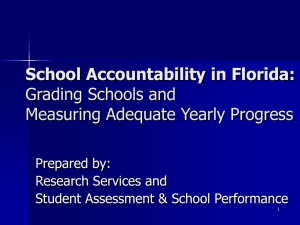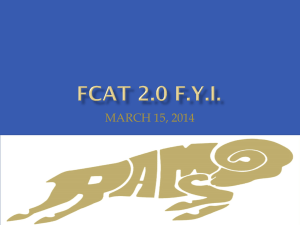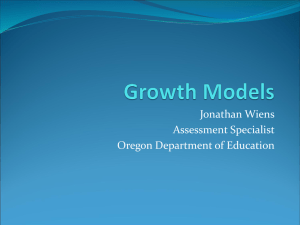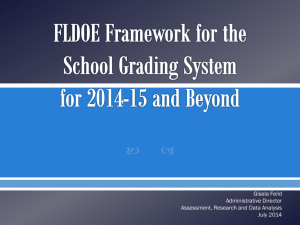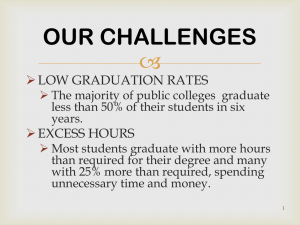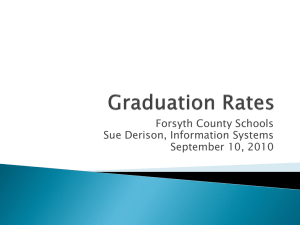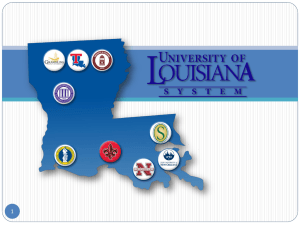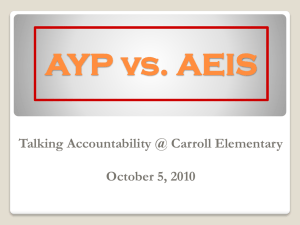School Grades and AYP Powerpoint
advertisement
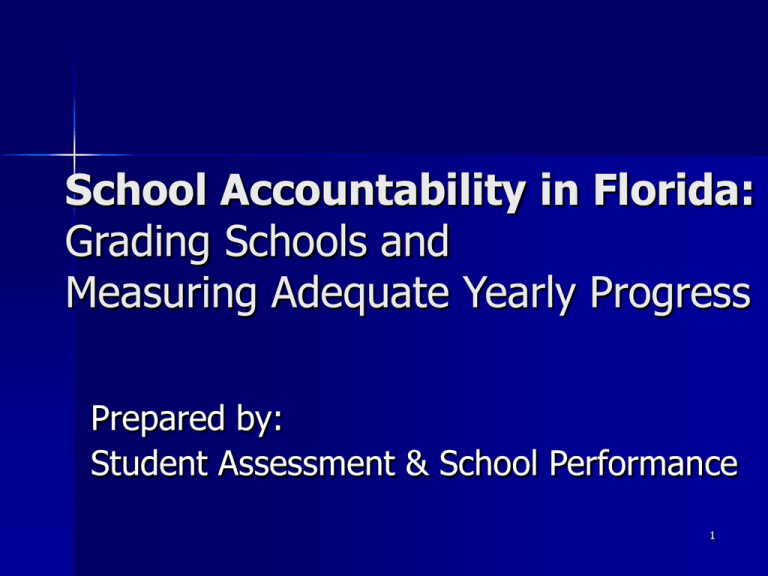
School Accountability in Florida: Grading Schools and Measuring Adequate Yearly Progress Prepared by: Student Assessment & School Performance 1 School Grades Schools are graded based on the percentage of students who reach specific criteria in 8 measures. Achieving High Standards • Level 3 and above in reading (grades 3-10) • Level 3 and above in math (grades 3-10) • Essay Score 4.0 and above in writing (grades 4, 8, and 10) • Level 3 and above in science (grades 5, 8, and 11) Learning Gains • Learning gains in reading (grades 3-10) • Learning gains in math (grades 3-10) • Learning gains of lowest 25% in reading (grades 3-10) • Learning gains of lowest 25% in math (grades 3-10) 2 How Are Learning Gains Defined? 1. Improving from one FCAT Achievement Level to the next (example: Level 3 to Level 4) 2. Maintaining FCAT Achievement Level 3, 4, or 5 3. Students remaining FCAT Levels 1 or 2 and achieving more than one year’s growth on the FCAT developmental scale 3 Developmental Scale Score Learning Gains Cut Points Grade Level 3 to 4 4 to 5 5 to 6 6 to 7 7 to 8 8 to 9 9 to 10 Reading 230 166 133 110 92 77 77 Math 162 119 95 78 64 54 48 Students must register a gain of one point more than the numbers listed above. 4 Learning Gains • • Students who drop a level (Level 4 to 3 or Level 5 to 4) are not counted as a learning gain Retained students who are Level 1 or Level 2 must improve at least one level in order to be counted as a learning gain 5 Learning Gains (FAA) Learning gains for students who take the Florida Alternate Assessment (FAA) are included in School Grade beginning in 2009-10. The FAA has nine separate performance levels, ranging from 1 to 9, with 4 or higher equaling proficient. A learning gain is defined as an improvement in performance level or the maintenance of a proficient level. 6 Science and Writing Schools with less than 10 students will still receive the district average. – In the past schools with less than 30 students received the district average. FCAT writing essays will be scored by one reader. Schools will be accountable for the percentage of students scoring a 4 and above. AYP will remain 3.0 and above 7 FCAT Grade Scale Grade Points A 525-800 B 495-524 C 435-494 D 395-434 F 0-394 8 Adequate Progress At least 50% of students in the bottom 25% must demonstrate learning gains in reading and math “A” Schools • Must register adequate progress in the current school year “B” and “C” Schools • Must register adequate progress in the current or prior school year Failure to make Adequate Progress for two consecutive years results in reduction of letter grade, regardless of number of points earned. 9 Adequate Progress Exception A, B, and C schools that do not meet the 50% learning gains requirement will not be penalized one letter grade if: •40% or more of lowest quartile students make gains in Reading and Mathematics and this percentage is at least a 1 percentage point increase from the prior year •Less than 40% of lowest quartile students make gains in Reading and Mathematics and this percentage is at least a 5 percentage point increase from the prior year 10 New High School Grading Beginning in 2009-10 schools serving a 9-12 population will be graded based: – 50% on the 8 FCAT components and – 50% on the school’s: graduation rate, performance and participation in accelerated courses, graduation rate of at-risk students, postsecondary readiness, and growth and decline in the data components from year to year. Performance on state end-of-course assessments when they become available. 11 Graduation Rate Students Not Included in the Calculation Graduates (4 year) Non-Graduates Students who transfer to: Other schools (public, private, or DJJ facilities) Standard Dropouts Diploma Special Home-education Adult education Deceased Diploma Certificate GED of Completion recipients Continuing enrollees who are not on-time graduates students 12 Participation in Accelerated Coursework Numerator Denominator 11th-12th graders who took an accelerated exam or dual enrollment course AND 9th-10th graders who passed an accelerated exam or dual enrollment course (weighted) All 11th-12th graders For a school to receive credit for participation in an accelerated course that ends in an exam (e.g., AP, IB, AICE), the student must take the exam. For dual enrollment, a student must earn a grade in the course for a school to receive credit for participation. For industry certification, a student must have taken an industry certification exam on the SBE approved “Industry Certification Funding List” for the year. 13 Performance in Accelerated Coursework Numerator Denominator Number of successful outcomes All 11th-12th graders who took an in accelerated coursework by a accelerated exam or dual student (9th through 12th grade) enrollment course AND 9th-10th graders who passed an accelerated exam or dual enrollment course Students will receive weight based on the number of postsecondary courses for which the student earns credit: – Dual Enrollment- a C or better equals credit in one course. – Industry Certification- 1 or multiple successful outcomes based on statewide articulation agreements (http://www.fldoe.org/workforce/dwdframe/artic_frame.asp) – AP, IB, and AICE- determined by the Credit-by-Exam Equivalencies List. 14 (http://www.fldoe.org/articulation/pdf/ACC-CBE.pdf) Weighting for Participation and Performance Schools will earn weighted credit for participation and performance based on this weighting system to accommodate multiple enrollments or successful completions: Weight Outcome 1.00 1 Exam/Course 1.10 2 Exams/Courses 1.20 3 Exams/Courses No cap is proposed for participation or performance. That is, schools will earn an increasing amount of credit for those students who take/pass increasing numbers of accelerated courses/exams. One tenth of a point will be added for each course/ successful outcome for a student. 15 Postsecondary Readiness Numerator Denominator Number of students scoring “ready” on SAT, ACT, and/or CPT any time during their high school careers On-time high school graduates who scored a Level 3 or higher on the 10th Grade FCAT Separate Measures for Reading and Math. If a student takes multiple tests (ACT, SAT, or CPT), the student’s highest score by subtest is used. The scores used to define “ready” are: ACT SAT CPT Reading 18 440 83 Mathematics 19 440 72 16 Graduation Rate for At-Risk Students Use same method of calculation used for overall graduation rate calculation. Subset of overall cohort – include only those students that earned a Level 2 or lower on both FCAT Reading and Math in 8th Grade. If a school does not have at least 10 students in that subgroup, the school’s overall graduation rate will be substituted for this measure. 17 Growth or Decline in components Schools earn an escalating number of points based on the magnitude of their improvement. Additional points would be awarded based on the number of points the school improved (growth from prior year); up to 20 additional points. Schools will lose 5 points if a component declines by 10 percentage points or more. EXAMPLES GROWTH: A school’s acceleration performance improves from 25% to 32%; the school earns an additional 7 points resulting in a total of 39 points (32 + 7). DECLINE: A school’s acceleration performance declines from 30% to 20%; the school would lose an additional 5 points resulting in a total of 15 points (20 – 5). 18 Additional Requirement Law stipulates that in order for a school that earns enough points for an “A” to be awarded an “A”, the school’s at-risk graduation rate must meet a certain threshold to ensure “adequate progress.” Threshold: – 75%; or 1 percentage point improvement over the prior year if percentage is within 10 points of the target 5 percentage point improvement over the prior year if percentage is beyond 10 points of the target This requirement is akin to the current learning gains requirement for the Low 25%. – If a school fails to make adequate progress for the low quartile and the at-risk graduation rate the school’s grade will only be reduced once. 19 High School Grading Matrix GRADUATION ACCELERATION READINESS Overall Rate 200 Participation 175 (in 2010-11) Performance on Reading 100 At-Risk Rate 100 Performance 125 (in 2010-11) Performance on Math 100 Total Graduation Points 300 Total Acceleration Points 300 Total Readiness Points 200 Total Points Possible 800 Things to Note All components are percentages. Those components weighted twice as much as others reflect a calculated percentage that is doubled (e.g., School X has a 75 points for graduation rate – School X earns 150 points (75*2) for that component). Over a 3 year period, the weighting of acceleration will be adjusted so that eventually both participation and performance will be weighted equally (150 points each). If a school earns points in excess of the total for a particular component – through the growth adjustment or the escalating weights in the acceleration components – the school will receive the maximum points for that component. 20 Bonus Points (High Schools) High Schools are eligible for 10 bonus points added to their total school grade points, if at least half the 11th and 12th grade students in the school retaking the FCAT meet the graduation requirement (score of 300). Student who meet the graduation requirement with an ACT or SAT concordant score are not included. 21 HIGH SCHOOL GRADING SCALE A Current 800point scale 525-800 New 1600-point scale 1050-1600 B 495-524 990-1049 C 435-494 870-989 D 395-434 790-869 F Less Than 395 Less Than 790 22 Participation Rates “A” Schools • Must test at least 95% of students “B”, “C”, and “D” Schools • Must test at least 90% of students Failure to test at least 90% of students results in an “I” pending investigation and may result in a lowering of the letter grade. 23 Who Counts for School Grades? • • Students enrolled during the October and February FTE surveys Included for all components: – Standard Curriculum Students – ESE: Gifted, Hospital/Homebound, Speech Impaired – LEP: Enrolled in a ESOL program for more than 2 years prior to testing • Other ESE and LEP (less than two years) categories included in percent tested and learning gains. 24 No Child Left Behind Adequate Yearly Progress (AYP) Includes all students who took the FCAT and were enrolled during the October and February FTE surveys Participation is computed based on students enrolled during the February FTE survey who are still enrolled during testing Performance by Subgroup – Total – White, Black, Hispanic, Asian, American Indian – Economically Disadvantaged – Limited English Proficiency – Students With Disabilities 25 Subgroups Must test at least 95% of each subgroup with 30 or more students. Subgroups count for proficiency if: – 30 students and more than 15% of the school’s tested population (valid scores) OR – 100 students (valid scores) Students can be in more than one subgroup All students included in Total 26 ELL Subgroup FDOE has recently received approval for ELL students enrolled for less than one year to be exempted from the proficiency calculation for AYP. These students will still be included in participation for AYP. – To count towards participation in Mathematics a student must take the FCAT – To count towards participation in Reading a student must take the FCAT and/or CELLA The first year ELL students will be included in Writing and Graduation rate. 27 Annual Raising of the Bar 100 60 50 44 50 31 38 38 38 31 51 56 58 62 65 2010-11 70 72 74 79 80 2009-10 86 86 90 80 40 100 100 93 93 68 44 37 31 30 20 10 Reading 2013-14 2012-13 2011-12 2008-09 2007-08 2006-07 2005-06 2004-05 2003-04 2002-03 2001-02 0 Mathematics 28 Three Ways to Make AYP 2% 29 1. Meeting Standard Criteria Each Subgroup: – 95% of students tested in Reading and Math – 79% at level 3 or above in Reading – 80% at level 3 or above in Math Total Group: – 1% increase OR 90% in Writing scores at 3.0+ – 2% increase OR 85% in graduation rate School Grade “A”, “B”, or “C” 30 2. Safe Harbor Total and all subgroup participation rates and School Grade requirements must be met. Subgroup Participation rates, Writing, and Graduation requirements met. Decrease of at least 10% in the percent of non-proficient students. – A school had 55% of a subgroup level 1 or 2 in 2008-09. That school needs 49% or less in levels 1 and 2 during 2009-10 that school would make Safe Harbor for that subgroup and subject. 31 3. Growth Model School-wide Participation rates and School Grade requirements met. Subgroup Participation rates, Writing, and Graduation requirements met. Percent of students on track to be proficient in 3 years or less Students without at least two years of data are not included in the Growth Model 32 3. Growth ModelOn Track to Proficiency A trajectory is developed for each student. Developmental Scale Scores Student must reduce the gap between their prior year score and proficiency by at least 33% per year. 33 3. Growth ModelOn Track to Proficiency 2000 1715 DSS 1500 1245 973 1000 775 601 500 305 0 4 5 6 7 Grade On Track Trajectory Student 1 Student 2 Intermediate on track trajectory scores represent one third of the difference between the baseline and proficient score. 34 3. Growth ModelOn Track to Proficiency Grade Of Test Used As Enrollment The Basis For Trajectory Test Used As Target For Proficiency Years In Trajectory Percent Of Difference Closed Per Year 3 3 6 3 33% 4 3 6 3 33% 5 4 7 3 33% 6 5 8 3 33% 7 6 9 3 33% 8 7 10 3 33% 9 8 10 3 33% 10 9 10 2 50% 35 Correlation Between School Grades and AYP School Grades and AYP are based on separate computational methods. D or F schools cannot make AYP Differentiated Accountability – A, B, & C schools with 80% or more of AYP criteria and 2 to 4 years w/o AYP are Prevent 1 less than 80% of AYP criteria and 2 to 4 years w/o AYP are Prevent 2 80% or more of AYP criteria and 5 or more years w/o AYP are Correct 1 36 less than 80% of AYP criteria and 5 or more years w/o AYP are Correct 2 For Additional Information Florida Department of Education http://schoolgrades.fldoe.org/ Student Assessment & School Performance http://www.broward.k12.fl.us/studentassessment/ Research Services http://www.broward.k12.fl.us/research_evaluation/ResearchServices.htm School Improvement http://www.broward.k12.fl.us/schoolimprove/ 37

